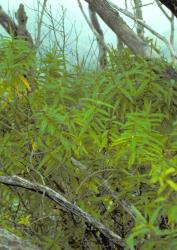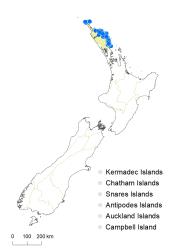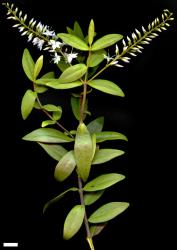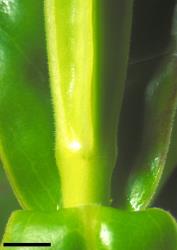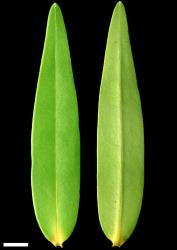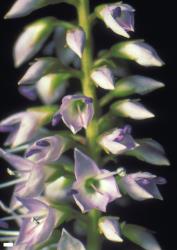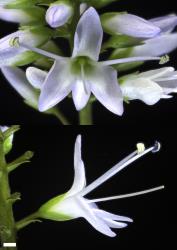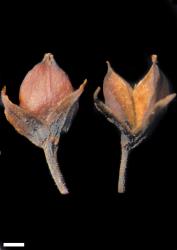- ≡ Hebe ligustrifolia A.Cunn.) Cockayne & Allan, Trans. New Zealand Inst. 57: 16 (1926)
Open, bushy or spreading shrub to 2.5 m tall, rarely (near Te Paki only) small tree to 8 m. Stems spreading to erect, eglandular-puberulent; hairs uniform. Leaf bud distinct, its leaves appressed at margins until near fully grown; sinus absent. Leaves sub-distichous to opposite-decussate, erecto-patent to spreading; lamina sub-coriaceous, linear-lanceolate to elliptic to oblong-elliptic, 12–100 mm long, 4–20 mm wide, dull, pale to dark green above, often yellowing on midrib and base, pale green beneath; midrib and 2 or more secondary veins evident; surfaces glabrous, or eglandular-hairy along midrib, or minutely glandular-hairy beneath; margin ciliolate, becoming glabrous, usually entire or rarely with a few distant, very shallow teeth; apex sub-acute to obtuse; base abruptly cuneate to rounded; petiole indistinct, 1–2 mm long. Inflorescence a lateral raceme, 25–80 mm long; flowers crowded, 15–70, all bisexual; bracts alternate or loosely whorled, the lowest sometimes opposite, narrowly lanceolate to ovate, usually <, rarely ≥ pedicels; pedicels erecto-patent to spreading, 1.0–2.5 mm long, eglandular-puberulent all around. Calyx lobes 4, or rarely a small 5th lobe present, sub-acute to acute or acuminate, 1.7–3.0 mm long, sub-equal, mixed glandular- and eglandular-ciliolate. Corolla 4–7 mm diameter; tube white, 1–3 mm long, ≤ calyx, puberulent inside; lobes white or pale purplish, erecto-patent to spreading, sub-equal, lanceolate to elliptic to ovate, 2.5–4.5 mm long, usually acute, rarely rounded at apex; nectar guides absent. Stamen filaments white or pale purplish, 5.0–6.5 mm long; anthers purplish. Style glabrous, 4–6 mm or rarely to 11 mm long. Capsules latiseptate, acute or sub-acute, glabrous, 2.5–6.0 mm long, 1.7–3.7 mm at widest point. Seeds discoid to ellipsoid, flattened, smooth, straw-yellow to pale brown, 0.9–1.8 mm long.
Veronica ligustrifolia plants are similar to other hebes that grow in Northland. The dull green leaves often have a yellowish base to the midrib. They have a distinctive, very flat vegetative bud.
Plants of V. flavida are similar in many respects, especially the yellow base to the midrib, but generally have longer leaves and are usually much taller. They are found in western Northland, whereas plants of V. ligustrifolia are mostly in the east. The identity of some plants from Hokianga Harbour and Waipoua Forest is discussed by Bayly & Kellow (2006).
V. rivalis plants have narrower leaves, pedicel hairs 80–100 µm long (cf. < 50 µm long in V. ligustrifolia), and calyx lobes hairy on outer faces.
V. stricta plants can be similar, but tend to have smaller flowers with elliptical and obtuse corolla lobes, longer corolla tubes in relation to the calyx, and in northern New Zealand they also have calyx lobes that are hairy on the outsides.
Plants of V. adamsii have thicker leaves and a sinus in the leaf bud.
North Island: Northland (Kerr Point, Surville Cliffs, Spirits Bay, North Cape Peninsula, Kapowairua, Cape Reinga; east coast from the base of Karikari Peninsula to Bream and Busby Heads).
Scrub, forest, cliffs, and slips, mostly coastal, rarely on sand. Recorded elevations range from 0 to 390 m, with one record at 600 m.
Flowers: January–December; fruits: January–December.
2n = 40 (see Bayly & Kellow 2006, as Hebe ligustrifolia).
Veronica ligustrifolia is classified in V. subg. Pseudoveronica sect. Hebe and the informal group “Occlusae” (Albach & Meudt 2010; Bayly & Kellow 2006).
The species’ distribution is disjunct between North Cape and the east coast of Northland, from near Karikari Peninsula to Bream Head. There is considerable variation in several characters, including leaf size, calyx lobe length, corolla tube and lobe length, style length, and capsule size.



